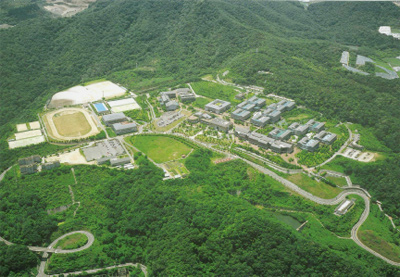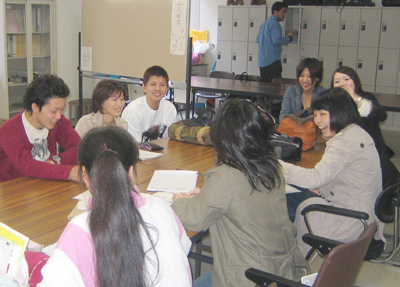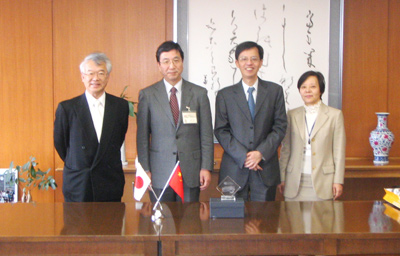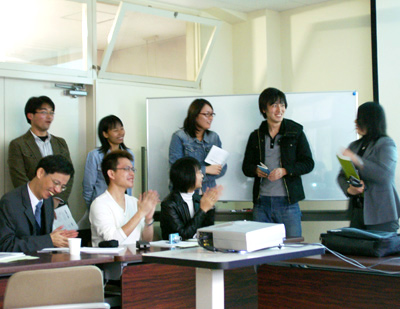
|
 |
| |
Fulfilling Their Mission
A Review of Japan's Universities of Education
Dr Lai Kwok-chan
Head of Strategic and Academic Planning
|
Teacher education in Japan has always been developed on multiple planes. Altogether there are 87 national universities in Japan, 48 of which - located in different parts of the country - shoulder the bulk of teacher education. Among the 48, 11 of them are dedicated purely to education. The remaining 30 plus institutions are comprehensive universities, with the education discipline being grouped either as a faculty or department of education.
In early April this year, when the sakura was in full blossom, I visited three universities of education, in Naruto, Osaka and Tokyo, each with its own distinctive features. It was a time when university staff and students were returning after a long holiday to start the new school year. Freshmen queued up to choose the subjects they wished to study, while overseas students were busy brushing up their communication skills in Japanese. Everyone on campus was looking forward expectantly to the days ahead.

|
Naruto University of Education |
 |
Relatively speaking, the Naruto University of Education is a small university. It is situated in the beautiful County of Takashima on Shikoku Island. It has a total number of about 900 students, 300 of whom are pursuing master's degree and a 100 PhDs. The University has established a Graduate School, offering master degree programmes in school education, special needs education and specialised subject education, among others. It also collaborates with the Hyogo University of Education to offer a joint doctoral programme in the science of school education. The College of Education at Naruto University is dedicated to pre-service teacher education in early childhood, primary, special needs, as well as junior secondary school education.
|
According to Professor Hiroshi Murata, Executive Director of Naruto University, in the face of a widening gap in learning abilities between secondary and primary school students in the early 1980s, the Japanese Government sought to enhance teacher skills and capabilities in classroom management and the handling of students with different standards. Very few Japanese universities at that time offered master degree programmes to cater for the needs of serving teachers. To solve the problem, the Japanese Government set up three universities of education - the Joetsu, the Hyogo and the Naruto - to provide postgraduate degree programmes for in-service teachers. The Takashima County Government, in particular, offered a two-year salary subsidy to schools that needed to employ substitute teachers to replace staff on study leave. As such, teachers under training could concentrate on their studies without any worries or constraints.

|
Established in 1949 together with six other universities of education in Japan, the Osaka Kyoiku University and the Tokyo Gakugei University are institutions with a much longer history. These eight universities, originally known as "gakugei universities" (meaning universities of liberal arts), were the result of an extensive amalgamation of early teachers' colleges in the locality. In 1967, they became "universities of education". The Tokyo Gakugei University, which retained its original name, is the only exception.
|

Osaka Kyoiku University |
 |
|
 |
Osaka Kyoiku University (also known as the Osaka University of Education) is situated on the outskirts of Osaka City. It is a university of impressive scale, boasting a main campus of 67 hectares. It has also established a branch campus in the city centre for the convenience of serving teachers. Currently, the University has 4,900 full-time students. It runs a total of 22 day-time programmes and one evening programme in teacher education, offering 15 arts and science subjects in the professional undergraduate studies programme. Additionally, the University's postgraduate school offers 18 master degree programmes in arts, science and fine arts. |
When asked about the history of teacher education in Japan, Professor Takashi Inagaki, President of Osaka Kyoiku University, said that universities of education in Japan had experienced a very tough period when the number of school-age children dropped and the demand for teachers was shrinking. The situation has improved slightly in recent years with a large number of teachers reaching retirement age, causing a gradual comeback in demand. According to Professor Inagaki however, the Japanese media has been very critical of teachers in recent years, leading to an erosion in respect for teachers in the country. |


Tokyo Gakugei University |
 |
This is Japan's largest university of education, with 13 kindergartens, primary and junior secondary schools attached to it. Its student numbers currently stand at 5,000 undergraduates and 1,000 postgraduates. Students come from every part of Japan. There are also over 500 overseas students, mainly from China, Europe, Africa, Myanmar and Laos. |
Tokyo Gakugei University offers a wide array of programmes. For undergraduates, there are pre-service teacher education and liberal arts programmes. The former accepts an intake of about 600 students, while the latter takes in about 400 to 500 students annually. Courses include "lifelong education", "international education", "human science and welfare", "environmental sciences and education", "art and culture" and "information education". More recently, the University joined hands with three neighbouring national universities - in Chiba, Yokohama and Saitama - to form a Conglomerate Graduate School of Education, offering doctoral programmes in education. |
When I was visiting Tokyo Gakugei University, I ran into a group of more than 30 HKIEd undergraduates who were visiting as well. They were being looked after by more than ten students from the University. The two groups communicated with each other in English. The HKIEd students gave a presentation to introduce the education system in Hong Kong, while their Japanese counterparts tried to illustrate life on campus with lively and interesting footage. The young people got along well and were soon touring the library and campus together. When it was time to say good-bye, it suddenly started to rain. I was very moved when the Japanese students insisted on going all the way to the railway station to see their Hong Kong friends off. Sheltering the visitors with their own umbrellas, they were soaked in the heavy rain themselves.  |
Conclusion |
The strongest impression I gathered from visiting the three universities of education, regardless of their scale and scope, is the large number of overseas students recruited. The Japanese Government even offers scholarships to research students and government officials from developing countries. Since their establishment, the universities of education in Japan have made the nurturing of quality teachers for the well-being of the community their mission. In recent years, the Japanese Government has also been determined to introduce a series of education reforms, where in-service teacher education has been institutionalised under a new system which requires validation of a teacher's qualifications every ten years. Adding to this momentum, Japan's universities of education have also set out to popularise their postgraduate schools, a move which will open up new horizons for teacher education in the country. |
|
|







